How to create a knowledge base for AI Agents: A complete guide
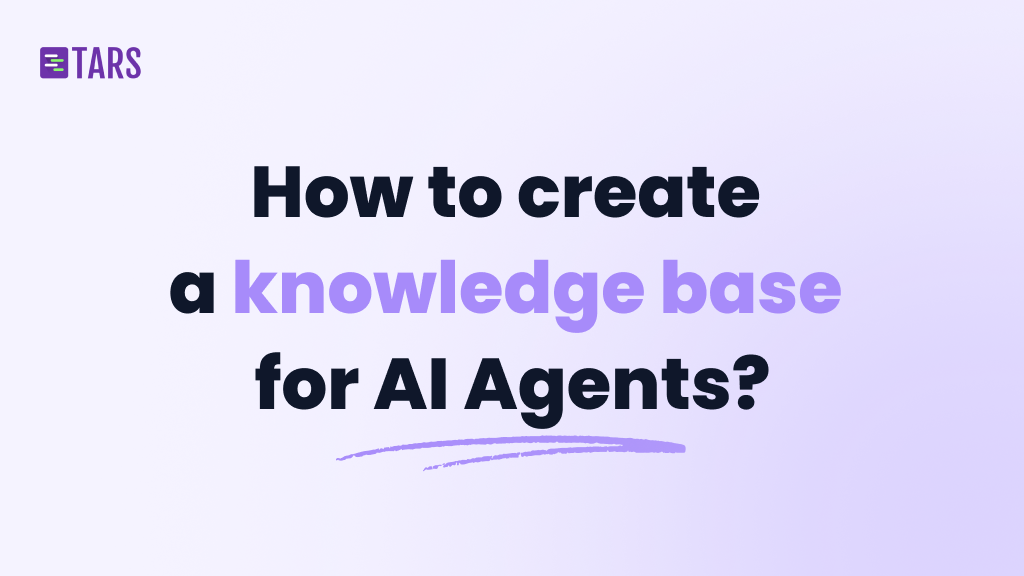
Building a good AI Agent starts with one thing: a solid knowledge base. At Tars, we’ve helped thousands of businesses create AI Agents that actually help their customers instead of frustrating them. The difference? It comes down to how you organize your information.
When customers want to solve problems themselves, having a good knowledge base isn’t optional anymore. It’s essential.
Whether you’re building a support bot, sales assistant, or internal help Agent, your AI’s answers are only as good as the information you give it. This guide will show you how to create knowledge bases for your AI Agents.
What is a knowledge base for AI Agents?
Before learning, how to create a knowledge base for AI Agents it important to understand one. A knowledge base is where your AI Agent gets its smarts. It’s basically an online library of information about your products, services, or company that your Agent searches through to answer questions.
Here’s the thing: information lives everywhere in your company. It’s scattered across emails, support tickets, documents, and in people’s heads. A knowledge base pulls all this scattered information into one place so your AI Agent can actually find and use it.
You don’t need one giant database. Most successful AI Agents use different types of knowledge sources working together. Each type has its own strengths and needs different care.
Why your business needs a strong knowledge base
Today’s customers expect instant answers. They don’t want to call, email, or fill out forms. They want their answer right now. A good knowledge base delivers several benefits:
Everyone gives the same answers: When your whole team uses the same information source, customers get consistent help whether they talk to sales, support, or your AI Agent.
Problems get solved faster: Customers find answers immediately instead of waiting for callbacks or getting transferred between agents.
Training gets easier: New employees learn from the same up-to-date information, which saves time and money.
Your team can handle growth: As you get more customers, your knowledge base handles more questions without burning out your staff.
Help is always available: Unlike people, your knowledge base works 24/7.
Types of knowledge bases you can use
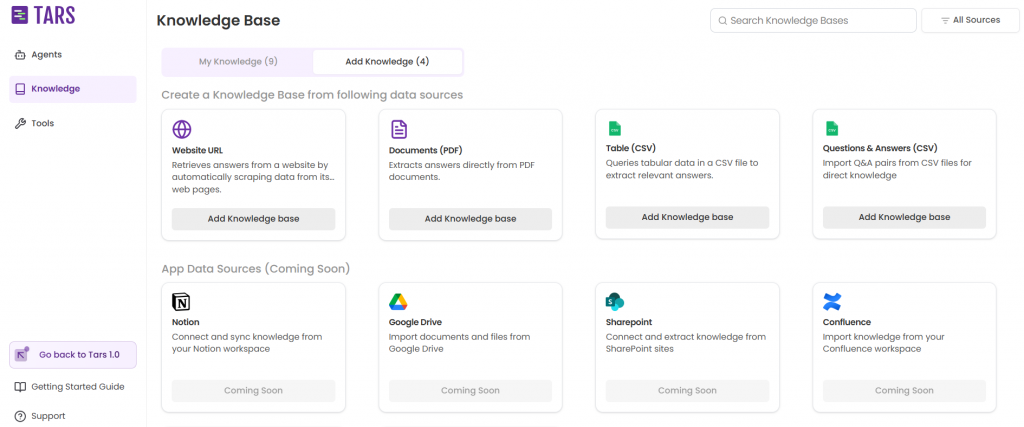
Your knowledge base can pull information from anywhere in your company. Here are the main types:
Website-based knowledge bases
What it is: All your existing website content – pages, blog posts, FAQs, product info.
Works best for:
- Companies with lots of website content
- Businesses that regularly publish new information
- Organizations with good SEO content
How to manage it: Your website changes all the time, so it needs constant attention.
Keep content fresh: Check your pages monthly. Update pricing, remove old products, fix outdated contact info. Wrong information makes customers angry and confuses your AI Agent.
Organize clearly: Use proper headings (H1, H2, H3) to show how information connects. Create logical paths that match how customers think about your business.
Write naturally: Use the same words your customers use. If they say “broken,” don’t write “malfunctioning.” Your AI Agent will work better when your content matches real questions.
Update regularly: Set up systems to check your website content automatically so your AI Agent always has current information.
PDF knowledge bases
What it is: Documents like manuals, guides, policies, and procedures.
Works best for:
- Companies with detailed product manuals
- Organizations with compliance documents
- Businesses with step-by-step procedures
How to manage it: PDFs don’t change automatically, so they need to be really well organized from the start.
Name files clearly: Use names that make sense. Instead of “Manual_v2_final.pdf,” try “Product_setup_guide_2024.pdf.” Include dates and clear descriptions.
Structure content well: Design PDFs so AI Agents can read them easily. Use clear headings, consistent formatting, and logical flow. Add bookmarks for navigation.
Focus each document: Don’t try to cover everything in one PDF. Make focused documents that thoroughly cover specific topics.
Control versions: Keep strict track of versions. When you update a PDF, remove or clearly mark the old one. Include version numbers and “last updated” dates.
Make them searchable: Ensure PDFs contain actual text, not just images. Use proper formatting and add descriptions for images.
Spreadsheet knowledge bases
What it is: Organized data in Google Sheets or Excel – product catalogs, pricing, contact lists, operational data.
Works best for:
- Online stores with product catalogs
- Service companies with pricing information
- Organizations managing large databases
How to manage it: Spreadsheets are flexible but need disciplined management.
Keep data consistent: Set up rules for data entry. Use dropdown menus and validation to prevent errors. One typo can make information invisible to your AI Agent.
Review regularly: Check data monthly for errors, duplicates, and old information. Set up highlighting to catch problems like missing information.
Control access: Limit who can edit to prevent accidents. Use comment modes for collaboration while protecting your data.
Back up everything: Set up automatic backups. Cloud tools like Google Sheets save versions, but extra backups add security.
Use clear headers: Write column headers that AI Agents understand. Instead of “SKU” or “DESC,” use “Product_code” and “Product_description.”
Additionally, there are multiple other forms of data sources, like your CRM or even your Slack channel, that are gold mines of knowledge. Structuring data and channels can help in similar ways in these sources as well.
How to create a knowledge base for AI Agents: Step by step
Step 1: Find your most important questions
Start with questions customers ask repeatedly. Don’t guess – use actual data.
Check support tickets: Look through your support history for common questions. If possible, use CRM tools that can spot patterns automatically.
Talk to customer-facing teams: Your sales, support, and customer success people know what customers really ask about. Meet with them regularly.
Use website analytics: Tools like heat mapping can show you where customers get stuck on your website.
Watch community discussions: If you have forums or social media, see what people talk about most.
Step 2: Find your existing information
Before creating new content, see what you already have:
- Website content and blog posts
- Manuals and documentation
- Spreadsheets and databases
- PDFs and procedure documents
- Internal wikis
- FAQ documents and support scripts
Step 3: Organize your structure
Structure your knowledge base around how customers think, not how your company is organized.
Use customer categories: Group content by customer needs like “Getting started,” “Troubleshooting,” and “Advanced features” instead of by internal teams.
Make navigation easy: Design so people can find answers without thinking hard. Put search bars prominently and organize frequently asked questions where people expect them.
Plan for growth: Create a structure that can handle new products or services without starting over.
Step 4: Choose contributors and set guidelines
Pick the right people: Include team members who talk to customers regularly (support and sales) plus experts who know the technical details (product managers, engineers).
Create writing rules:
- Write simply without jargon
- Use consistent formatting
- Use keywords customers actually search for
- Add image descriptions for accessibility
Set up quality checks: Create review processes to ensure everything is accurate and consistent.
Advanced practices for better knowledge bases
Make complex information simple
Good knowledge base design makes finding answers effortless. Use clear, consistent categories so customers find information quickly.
Design principles:
- Put common tasks where people see them first
- Use titles with keywords people actually search for
- Break up long text with spaces and images
- Use pictures, screenshots, and videos for complex topics
Create personalized experiences
Don’t overwhelm customers with everything at once.
Personalize content: Build separate help sections for different products instead of mixing everything together.
Improve search: Use AI-powered search that understands what people mean, even when they don’t use perfect keywords.
Show information in layers: Give basic answers first, then let people go deeper if they need more detail.
Use analytics to find problems and opportunities
Analytics show you how your knowledge base really performs:
Track important numbers:
- Which content gets used most
- Search terms that find nothing
- Customer ratings and feedback
- How long people spend reading vs. leaving quickly
Use AI for insights: Let AI identify trending topics, find content gaps, and tell you when articles need updates.
Keep improving: Regularly check your analytics to see what helps customers and what needs work, then make changes.
Let customers help each other
Sometimes customers can answer questions better than you can.
Community forums: Create spaces where users share experiences and solutions.
Customer-created content: Encourage customers to write their own guides and tips.
Recognize helpers: Highlight customers who consistently give good answers to keep people engaged.
Keeping your knowledge base working well
Building your knowledge base is just the start. Maintaining it is what makes it valuable:
Set up regular reviews
Content checks: Schedule regular reviews to make sure information stays accurate as your business changes. Set up alerts for content that hasn’t been updated recently.
Performance analysis: Use numbers like page views and user feedback to see what content helps versus what needs improvement.
Gap analysis: Regularly check support tickets and customer feedback to find new topics you need to cover.
Keep content current and relevant
Version control: Create clear processes for updating content. Make sure old information gets properly removed or archived.
Get input from different teams: Make sure marketing, product, and customer-facing teams help manage the knowledge base.
Use feedback: Create ways to collect and act on user feedback, ratings, and suggestions.
Avoid common mistakes
Disconnected information: Don’t create separate knowledge sources that contradict each other. Have one clear answer for each topic.
Ignoring mobile users: Make sure your knowledge base works well on phones, since many customers use mobile devices.
Poor search optimization: Use words your customers use, not internal company language. Include keywords people actually search for.
Too much complexity: Keep organization simple – complexity confuses both AI Agents and people.
The future of knowledge base management
As AI technology improves, knowledge base management gets more sophisticated. Look for opportunities to:
- Automate content updates where possible
- Use AI to find content gaps and problems
- Create content that adapts to user behavior
- Build systems that learn from user interactions
Key takeaways: How to create a knowledge base for AI Agents
Creating a good knowledge base for AI Agents takes planning, consistent maintenance, and understanding what your customers actually need. Follow the strategies in this guide and choose the right mix of knowledge sources for your business. You’ll build AI Agents that deliver great experiences and real business results.
Remember: your knowledge base is only as good as the work you put into maintaining it. Invest in proper structure and regular updates, and your AI Agent will become genuinely valuable to your business.
A writer trying to make AI easy to understand.
- What is a knowledge base for AI Agents?
- Why your business needs a strong knowledge base
- Types of knowledge bases you can use
- Website-based knowledge bases
- PDF knowledge bases
- Spreadsheet knowledge bases
- How to create a knowledge base for AI Agents: Step by step
- Step 1: Find your most important questions
- Step 2: Find your existing information
- Step 3: Organize your structure
- Step 4: Choose contributors and set guidelines
- Advanced practices for better knowledge bases
- Make complex information simple
- Create personalized experiences
- Use analytics to find problems and opportunities
- Let customers help each other
- Keeping your knowledge base working well
- Set up regular reviews
- Keep content current and relevant
- Avoid common mistakes
- The future of knowledge base management
- Key takeaways: How to create a knowledge base for AI Agents


Build innovative AI Agents that deliver results
Get started for freeRecommended Reading: Check Out Our Favorite Blog Posts!
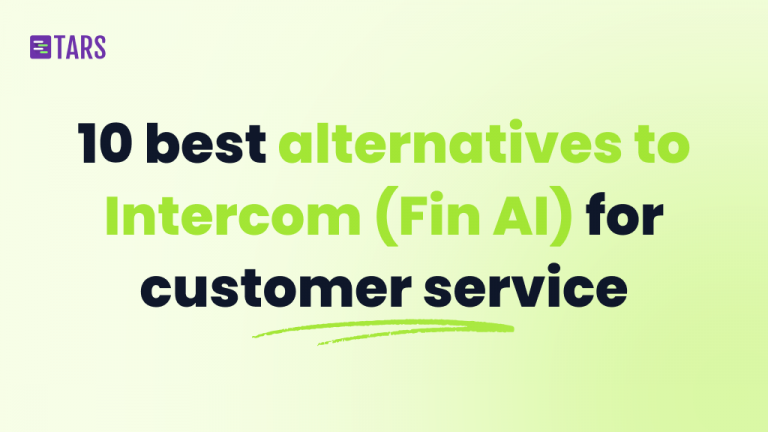
10 best alternatives to Intercom (Fin AI) for AI-powered customer service [2025]
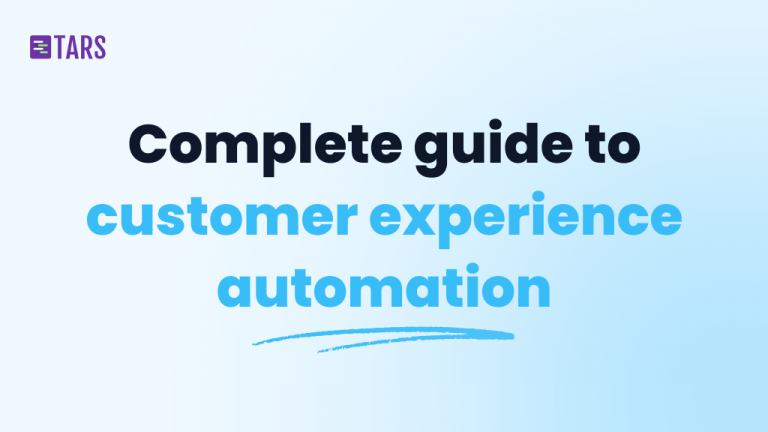
Customer experience automation: The complete guide to CXA in 2025
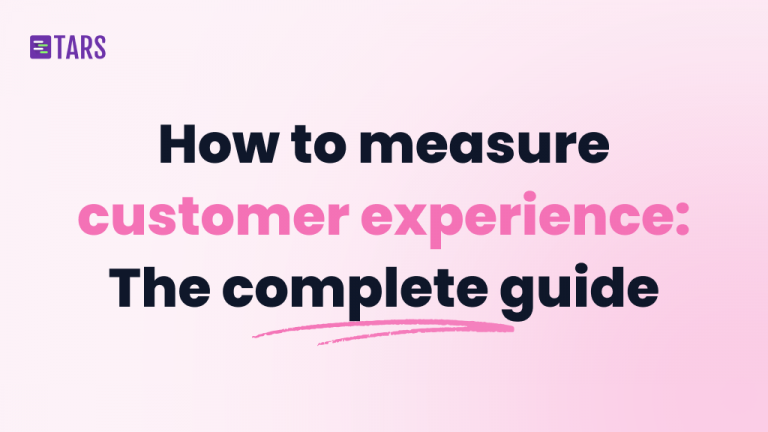
How to measure customer experience: The complete guide for AI-powered support and growth

Our journey in a few numbers
With Tars you can build Conversational AI Agents that truly understand your needs and create intelligent conversations.
years in the conversational AI space
global brands have worked with us
customer conversations automated
countries with deployed AI Agents